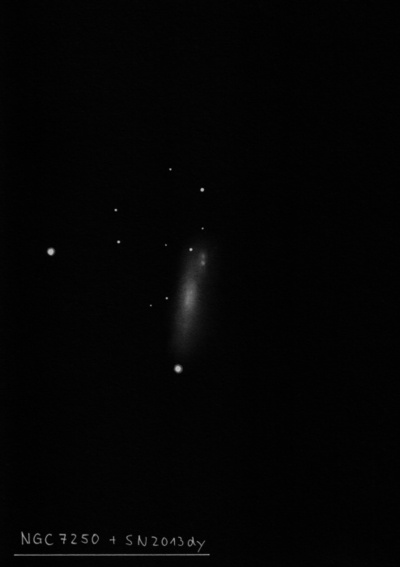
William Herschel discovered NGC 7250 = H III-864, along with NGC 7248, on 8 Nov 1790 (sweep 977) and recorded "vF; S; mE; 300 showed it very plainly. The extension from about 75° np to sf; bM." His position is 12 seconds of RA too large (typical error).
300/350mm - 13.1" (8/24/84): fairly faint, very elongated streak NNW-SSE, small bright core. A mag 11 star is off the SSE tip 0.9' from center. Pair with NGC 7248 17' WSW. This galaxy may be an interacting double system but it was not resolved.
400/500mm - 18" (10/19/06): fairly faint, fairly small, very elongated NNW-SSE, 0.6'x0.2', very small bright core. A mag 11 star is just off the SSE end. The galaxy fades at the tips, so the full extent was difficult to determine but appears to extend to 1.0'x0.25'. A very faint knot (PGC 214816) is occasionally visible at the NNW end. This nearly stellar "knot" is often noted as an interacting companion, though it may be a bright HII complex in the galaxy. NGC 7250 is classified as a starburst galaxy.
600/800mm - 24" (9/2/16): at 200x; this disrupted galaxy or interacting pair appeared moderately bright, elongated 5:2 N-S, 0.7'x0.3', bright core. A small, very faint knot or extension is at the north end. A mag 10.9 star is 0.9' SE of center. At 375x; the "knot" attached on the west side of north end of the galaxy extends ~20"x10" NNW-SSE (slightly different PA than the main galaxy), increasing the total size of the merged glow to nearly 1.0'x0.3'. HyperLeda catalogues the object at the north end as a galaxy (PGC 214816), though on the SDSS it appears to be a collection of blue knots. NGC 7248 is 17' WSW.
24" (8/7/13): moderately bright, fairly small, elongated 5:2 N-S, 0.75'x0.3', sharply concentrated with a very small brighter nucleus. A mag 11 star is just off the SSE edge. The structure at the north end was masked by Type-Ia supernova 2013dy at mag 13-13.5, which was discovered on July 10th, a couple of weeks before maximum. The supernova was 2" W and 25" N of the nucleus of NGC 7250.
Notes by Steve Gottlieb